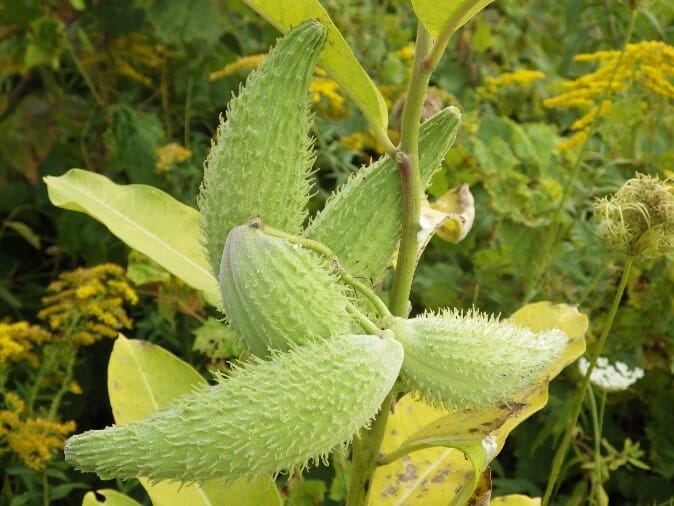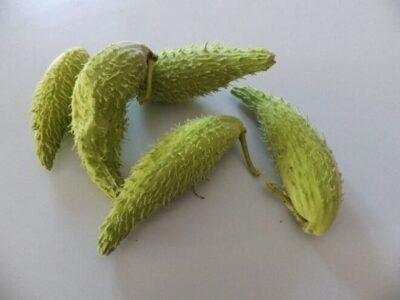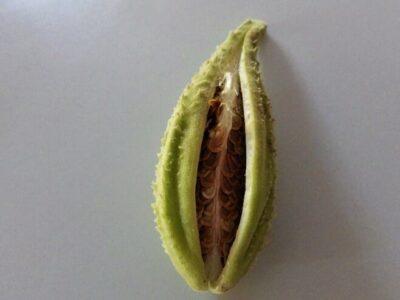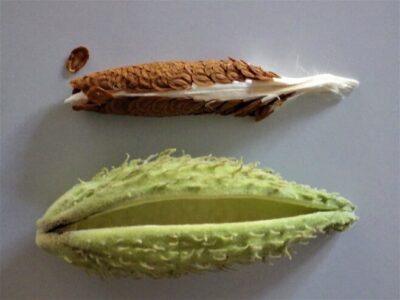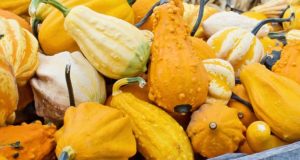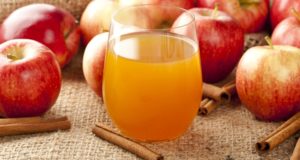August, September and early October are the prime months for milkweed pods in many parts of North America. The pods range in size from 2 to 4 inches and grow in clusters of 4 to 8 pods.
They’re typically a light green color and filled with a combination of seeds and soft, silky floss. I’ll usually collect about 20 or so pods and head to the kitchen or camp.
In early to mid-summer, the milkweed shoots first emerge, and they taste great when gently boiled, shocked and sautéed in butter or olive oil. We’re going to start with the pods because they’re in season now, and cover the spring shoots later.
Prepping the Pods
Raw milkweed pods are quite bitter and the white, milky sap is not exactly appetizing. It is also very sticky. They have numerous seeds and a stringy, silky floss inside of the pod. In order to remove the bitterness and the sap, they must be boiled in water and shocked in ice water, and then boiled and shocked again. (The duration for boiling is 10 minutes and then a shock in ice water followed by another 2 minutes in boiling water and a final shock in ice water.) This is done for any milkweed pod, regardless of its size.
Pocket-sized Solar Generator Provides Backup Power In Any Crisis
Prior to the boiling water/ice-water shock, the seeds and silky floss need to be removed.
This can be done by gently pulling the seam apart with your thumbs on the curved back of the pod and pulling out the silk and the seeds.
There is also a tough, inner lining or membrane that needs to be removed. This is easy to do after the first boil and shock by gently pulling the tough membrane from the pod.
Large pods up to 4 inches are the best for stuffing. The best cooking methods involve baking or sautéing.
One thing you’ll notice during the first boil is a lot of bubbles and the white sap floating to the surface.
That’s good news, and you don’t have to skim the surface. The ice-water shock will rinse them.
After you’ve chilled them for a few minutes in the ice water and you’ve removed the tough inner membrane, boil them again for 2 minutes. You shouldn’t see any more sap or bubbles. You’re just giving them a final rinse and finish to clean the now-exposed inner membrane of the pod, and they’re ready for stuffing.
Baked and Stuffed Milkweed Pods
Larger milkweed pods up to 4 inches are the best for stuffing. You can stuff them with any combination you like, but I prefer a mix of chopped vegetables and a cheese-like mozzarella or cream cheese. However, you can use any cheese. I’ve also tried some variations with chopped fruit. Here’s a sample recipe with the cheese blend and the proportions if you want to give it a try.
Ingredients:
- 24 to 30 large prepped milkweed pods, about 3 to 4 inches in length.
- 8 ounces of cream cheese or 8 ounces of shredded mozzarella.
- 2 tablespoons of onion, finely diced.
- 1 jalapeno finely diced or two tablespoons of sweet bell pepper.
- 3 tablespoons of crispy, diced bacon.
- Bread crumbs or corn meal.
- Salt and pepper.
Directions:
-
Preheat the oven to 375 degrees Fahrenheit.
- Combine the cheese in a bowl with the diced pepper, diced onion and bacon; salt and pepper to suit your taste and combine everything with a large wooden spoon.
- Stuff the pods until they’re full, but not so much that you can’t close the seam in the side of the pod. You can either stuff the whole pod, or cut them in half to create a half-shelled pod and simply spoon the stuffing on top.
- Coat the seam with some bread crumbs or corn meal to help seal the pod during baking if you’re using a whole pod, and you can also sprinkle some on top of the half-shelled pods.
- Place on a foil-lined baking sheet and bake for 15 to 20 minutes until the crumbs or corn meal are browned.
- Serve warm or cold with your favorite dip, or eat them plain.
Sautéed and Stuffed Milkweed Pod Halves
The large 3- to 4-inch pods also can be sautéed. Prep the pods the same way you would for baking, but break or cut them in half so they’re a half-shelled pod. Stuff them and sauté on the bottom of the pod only in 3 tablespoons of oil and 3 tablespoons of butter. Sauté for 4 to 5 minutes until they turn a golden brown.
Other Ways to Eat Milkweed Pods
- Unstuffed small pods. Small pods up to 2-inches in length can be eaten unstuffed with the immature seeds and immature floss. You’ll still need to remove the inner membrane. so gently remove the immature seeds and silk and give the small pods the hot water treatment for 10 minutes before removing the membrane. Repeat for 2 minutes in the boiling water, followed by the ice water shock. Once they’re prepped, re-insert the immature seeds and silk and bake or sauté. The immature seeds and silk actually have a creamy texture. Don’t boil the pods with the immature seeds and silk inside. They’ll dissolve in the boiling water.
- Salad or soup. Give the pods the boiling water/ice-water treatment and chill them in the refrigerator. Chop them and add them to a salad or soup.
- Milkweed chips. Chop the prepped pods into larger chunks and sauté or deep fry them for milkweed chips.
- In sauces. Dice the prepped pods and add them to a sauce like a marinara or chili.
Milkweed Shoots
Milkweed shoots show up in the Spring. They are surprisingly tender and not bitter. They look similar to dogbane shoots which are very bitter, but dogbane has pointy leaves and a smooth surface while milkweed shoots have a velvety leaf like sage and rounded leaves.
The best way to prepare milkweed shoots after you wash them is to remove the leaves from the stem and chop the stem into pieces about 2- to 3-inches long. Boil them for 3 minutes in salted water and then shock them in ice water. Drain the leaves and the shoots and sauté them in butter or olive oil. Sometimes I’ll add a little garlic.
They have an asparagus flavor note and the boiled and shocked leaves and stems also can be frozen for future use. A variation is to sauté them in rendered bacon fat and then top them with crumbled bacon.
Finally A Backup Generator That Doesn’t Need Gas!
Storing Milkweed Pods
Milkweed pods can be kept in the refrigerator and will have a shelf life similar to other produce in the fridge. The prepped pods also can be frozen and should be good for up to 3 months.
Milkweeds are easy to harvest and easy to prepare. Give them a try and who knows — you may really like them and try them again and again.
Have you ever eaten milkweed? Share your tips in the section below:
 Off The Grid News Better Ideas For Off The Grid Living
Off The Grid News Better Ideas For Off The Grid Living

